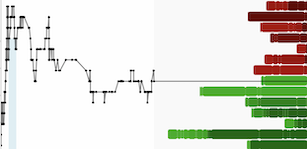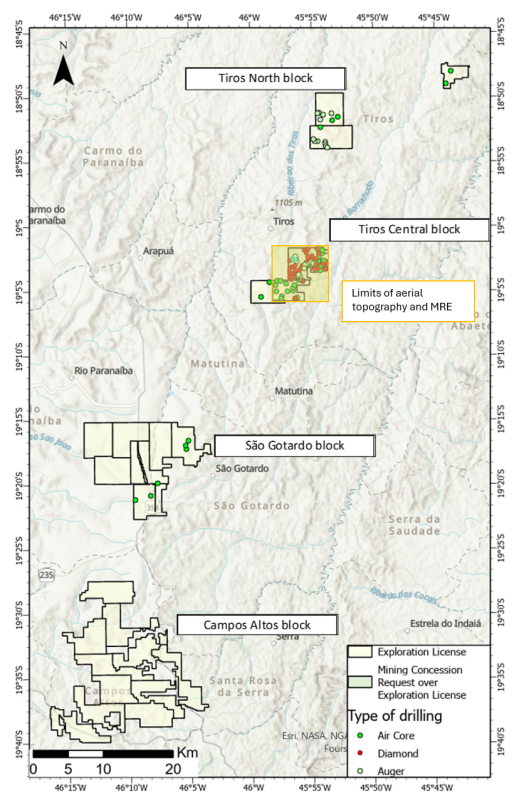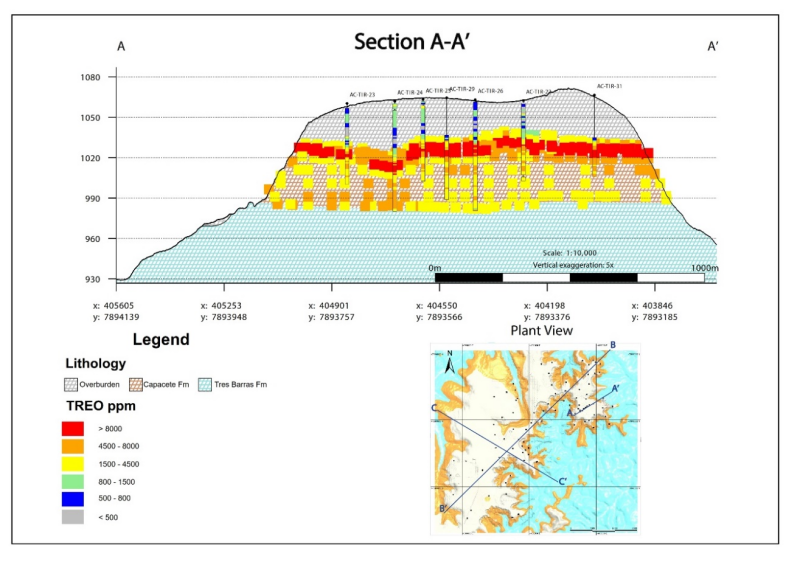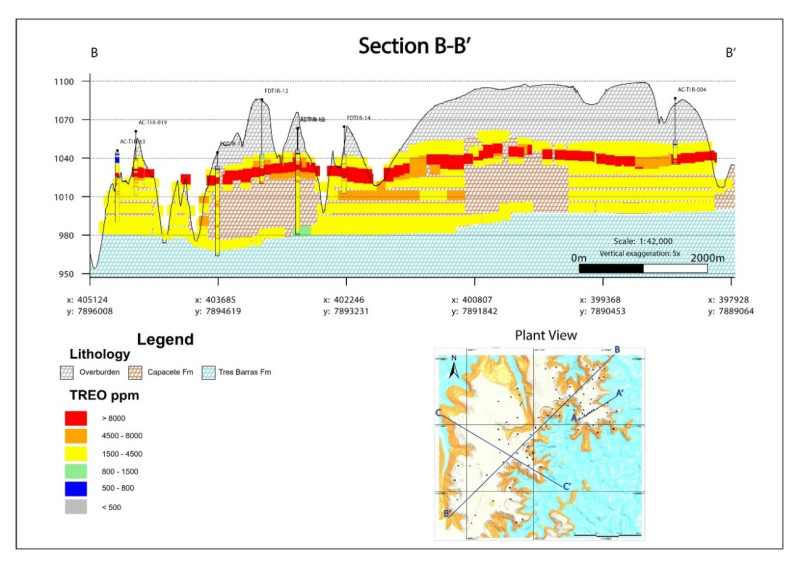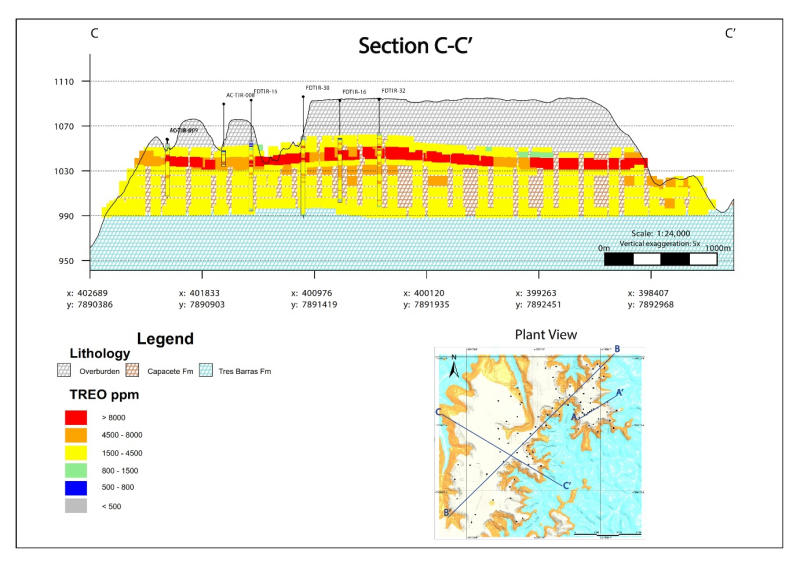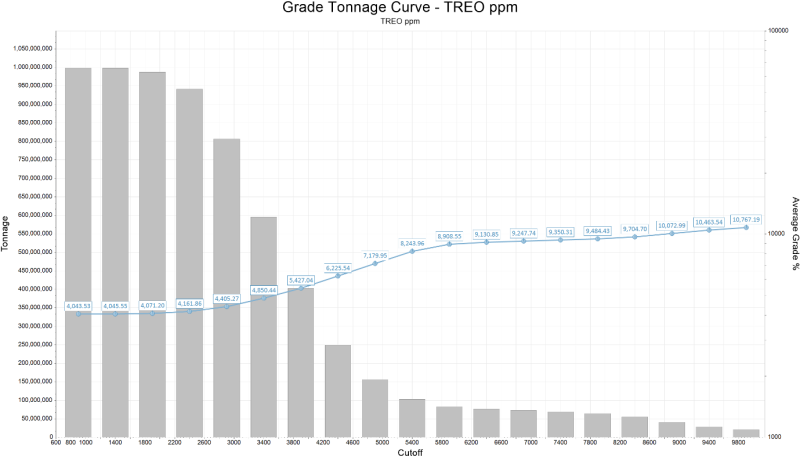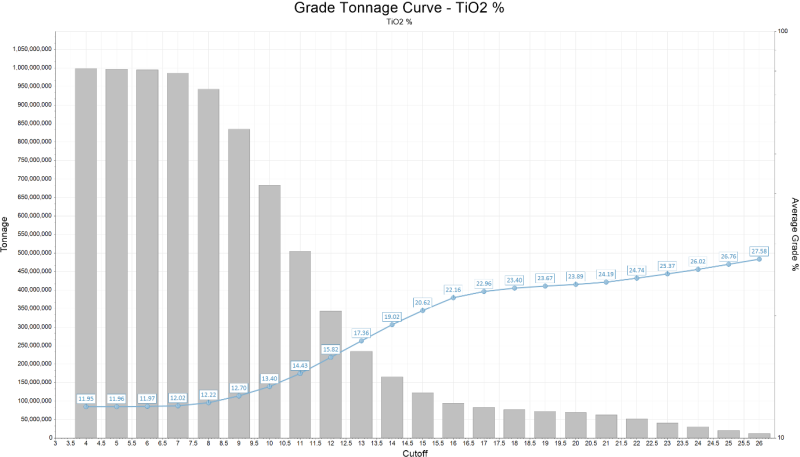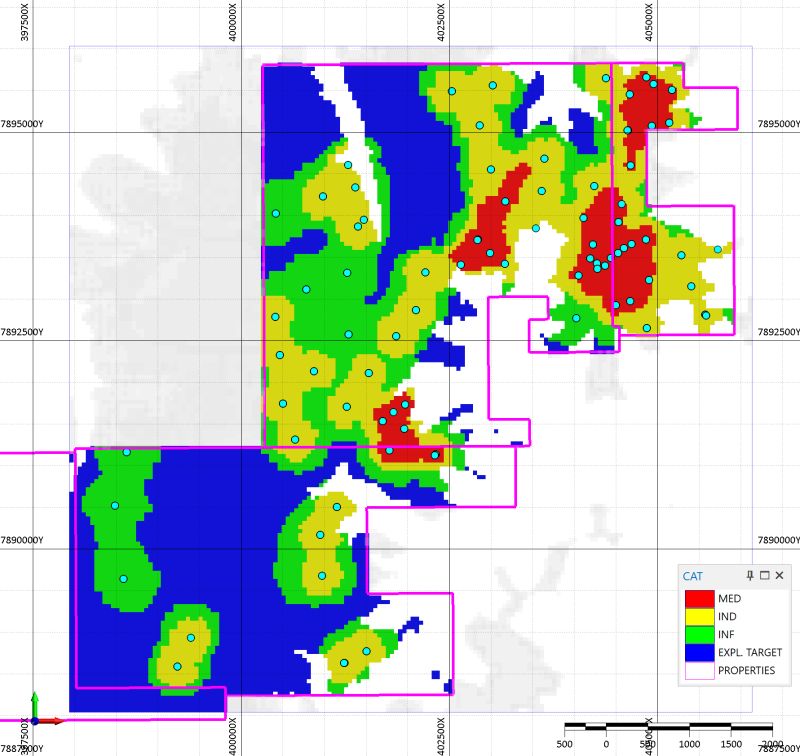(TheNewswire)
 | |||||||||
 |  | ||||||||
17 July 2024 – TheNewswire – Calgary, AB - Resouro Strategic Metals Inc. (ASX: RAU; TSX-V: RSM; FSE:BU9; OTC:RSGOGF) ("Resouro" or the "Company") is pleased to announce the publication of its maiden JORC-compliant Mineral Resource Estimate (“MRE”) for the Tiros Titanium and Rare Earth Elements Project in Brazil (“Tiros Project” or “Tiros” or “Project”) which marks a significant milestone in the Project’s development.
Maiden JORC MRE for the Tiros Project of 1.7 billion tonnes (bn tonnes) at 3,900 parts per million (“ppm”) Total Rare Earth oxide (“TREO”), 1,100 ppm Magnet Rare Earth Oxides (“MREO”) and 12% Titanium Dioxide (“TiO2”) in all three resource categories (refer to Table 1 below).
Of the 1.7 bn tonnes, the deposit contains a high grade domain of 120,000,000 tonnes at 9,000 ppm TREO containing 2,400 ppm of MREO and TiO2 of 23%.
The combined Measured and Indicated resources represent 1.0 bn tonnes at 4,050 ppm TREO containing 1,120 ppm MREO and 12% TiO2.
The MRE places the Tiros Project as one of the largest undeveloped titanium and rare earth resource globally and in Brazil.
|
DOMAIN |
CAT |
TONNES (t) |
TiO2 (%) |
TREO (ppm) |
MREO (ppm) |
|
HG (High Grade) |
Inferred |
42,000,000 |
23 |
8,700 |
2,200 |
|
Indicated |
55,700,000 |
23 |
9,030 |
2,380 |
|
|
Measured |
20,800,000 |
24 |
9,320 |
2,530 |
|
|
Sum |
120,000,000 |
23 |
9,000 |
2,400 |
|
|
MG (Medium Grade) |
Inferred |
620,000,000 |
11 |
3,500 |
950 |
|
Indicated |
704,000,000 |
11 |
3,650 |
1,020 |
|
|
Measured |
224,000,000 |
11 |
3,570 |
997 |
|
|
Sum |
1,500,000,000 |
11 |
3,500 |
930 |
|
|
Totals |
1,700,000,000 |
12 |
3,900 |
1,100 |
Table 1: JORC-compliant maiden MRE, Tiros Project, Brazil (1,000 ppm TREO cut-off). Mineral Resource estimates are not precise calculations, being dependent on the interpretation of limited information on the location, shape and continuity of the occurrence and on the available sampling results. The tonnage and grade figures in the resource statement are rounded off to reflect the relative uncertainty of the estimate, for this reason the summations may not add up.
-
The MRE incorporates 4,766 metres of verification drilling including Diamond, Aircore and Auger across 102 drill holes including 20 historical drill holes.
-
The maiden MRE is derived from the Central tenements of the Tiros Project, being ~7% of the tenements that comprise the total Tiros Project area.
-
The majority of the resource is open laterally and found to be homogeneous in nature.
-
Resource exists within Brazil’s most advanced mining state (Minas Gerais) with developed infrastructure, existing access to road, rail and port, in a supportive community, and a favourable environmental region which will support the development of the Tiros Project.
President, CEO, Director and Founder, Chris Eager commented:
“Completion of our maiden JORC-compliant Mineral Resource Estimate for the Central Block of the Tiros Rare Earth project marks a pivotal moment for Resouro Strategic Metals”
“The 1.7 bn tonnes of Measured, Indicated and Inferred Resource is contained in a flat lying consistently thick, near surface and highly weathered clay like material.”
“We consider that the average Resource grades of 3,900 ppm TREO, 1,100 ppm MREO and 12% of TiO2 are well above average for this style of deposit”
“The Resource has a discrete domain containing 120,000,000 tonnes at 9,000 ppm TREO containing 2,400 ppm of MREO and TiO2 of 23% which indicates the potential for the Tiros Project to be mined at a high grade in the initial years of production”
“Resouro has defined a very substantial resource over just 7% of the land area of the project. Step out drilling to the North and South demonstrates consistent thicknesses and grades up to 35 kilometers away from the Central Block”
“We have completed sufficient resource drilling at Tiros and the huge scale of the Maiden JORC Resource means Resouro does not need to add Resource tonnes. Infill drilling is ongoing for mine planning and Feasibility and Environmental purposes.”
“Resouro remains committed to sustainable practices and positive community engagement, ensuring that our growth contributes to the well-being of the regions in which we operate.”
“I would like to congratulate our Technical and Community Relations Team on the ground at Tiros for the work undertaken to derive a 1.7 bn tonne Resource in a short period of time”
“I look forward to updating the market on Resouro's progress to completion of our Preliminary Economic Assessment including the ongoing Metallurgical Test Work Programs.”
Atticus Geoscience (“Atticus”) has modelled the maiden MRE utilising the results of 102 drill holes across the Tiros central tenements (refer to figures 1 and 2) including 28 diamond drill holes, 29 Air Core holes, and 25 Auger holes undertaken by Resouro (2023 to 2024) and 1 diamond drill hole and 19 Air Core historical drill holes undertaken by previous tenement owners (Vicenza and Iluka, 2011 and 2016). Atticus and Resouro have undertaken resource modelling by focusing on neighbouring comparable studies and operations within the region and Brazil, and providing a tonnage based on preliminary metallurgy work expected to have reasonable prospects for eventual economic extraction. A conservative assumption of 1,000 ppm TREO (refer to figures 6 and 7) cut-off was applied to the resource estimation which delivered an MRE of 1.7 bn tonnes @ 3,900 ppm TREO (Measured, Indicated, Inferred) comprising of an outstanding 1,100 ppm MREO (Pr, Nd, Tb, Dy) and 12% TiO2. Notably, the MREO is the weighted average of Pr6O11, Nd2O3, Tb4O7 and Dy2O3 in this announcement (Figure 1).
The MRE was limited by the aerial topography covering 3,300 ha, which represents approximately 7% of the Resouro tenements that comprise the Project area. The MRE excludes neighbouring Resouro-owned tenements which indicate further potential for expansion.
Figure 1: Plan view of the Resouro tenements including the Tiros Ti + REE deposit (Tiros Central block) which is the subject of this mineral resources estimate
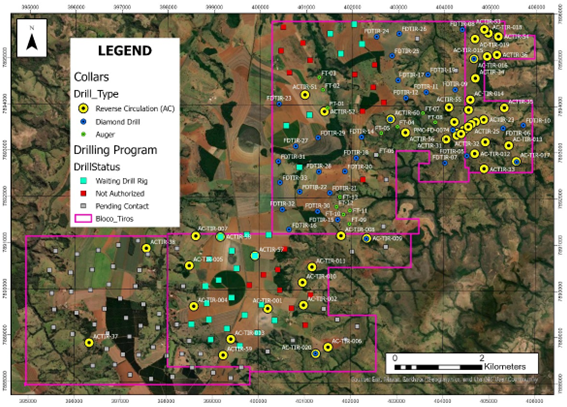
Figure 2: Plan view of the Tiros Ti + REE deposit (Tiros Central block) including the existing (and planned) exploration drill holes
Maiden Mineral Resource Estimate
The current maiden Mineral Resource Estimate at Tiros, applying a 1,000 pm TREO cut-off, presents 1.7 bn tonnes @ 3,900 ppm TREO with 1,100 ppm MREO (Pr, Nd, Tb, Dy). The Indicated and Measured resources represent 1bn tonnes at 4,050 ppm TREO containing 1,120 ppm MREO and 12.0% TiO2 with a High Grade zone identified as summarised in Table 1 and shown in Figures 3, 4 and 5. The drilling data to support the High Grade (HG) and Medium Grade (MG) is detailed in the JORC table 1 in appendix 1. The grade-tonnage curves for the mineral resource estimation are shown in Figures 6 and 7.
Figure 3: Section view (A-A) of the Tiros Ti + REE deposit showing High Grade (HG) in red (section is rendered with a x5 vertical exaggeration)
Figure 4: Section view (B-B) of the Tiros Ti + REE deposit showing High Grade (HG) in red (section is rendered with a x5 vertical exaggeration).
Figure 5: Section view (C-C) of the Tiros Ti + REE deposit showing High Grade (HG) in red (section is rendered with a x5 vertical exaggeration).
Rare earth and titanium mineralization are hosted in sandstones and conglomerates of the Capacete Formation, belonging to the Mata da Corda Group. Titanium is associated with the mineral anatase, originating from the alteration of perovskite. Rare earths are suspected to be associated with ionic clays.
The Capacete Formation is the result of the sedimentation of the erosion product of the rocks of the Patos Formation, also belonging to the Mata da Corda Group. The Patos Formation represents a voluminous set of Upper Cretaceous kamafugite pyroclastic flows and deposits, hosted in the Brasília Belt, southwest of the São Francisco Craton.
Three (3) types of drilling were carried out on the Project: diamond drilling, air core drilling and auger drilling. The following is a breakdown of the three types of drill holes used in the MRE, historical and current.
Historical drilling included Vicenza (2011), who completed a single diamond drill hole (HQ-size), oriented vertically and reaching 82.45 m. Nineteen 75 mm diameter air core drill holes were undertaken by the Iluka-Vicenza JV and totalled 914 m with depths of up to 60 metres.
Auger drilling undertaken by Resouro totalled 9 drill holes of 100 mm diameter, totalling 86.5 m and with depth of the holes up to about 15 metres. Air core drilling by Resouro totalled 23 holes totalling 1,425.5 m and up to depths of 85 metres. Diamond drilling (HQ-size) by Resouro totalled 32 drill holes totalling 2,285.65 m with depths up to 93 metres.
All holes were vertical and with depths below 100 m, therefore no trajectory measures were collected and deviation of the holes is presumed to be negligible.
Sampling and Sub-Sampling Techniques
Samples were taken from diamond, air core, and auger drill holes. All drilled material was sampled, with nothing being discarded. The sampling intervals were chosen based on geological description during logging of the drill core and pulverized cuttings. The samples were produced according to industry standard procedures.
Measures to ensure sample representativity, include setting up of a specific sampling procedure and having a dedicated-on-site full-time survey team. A QA/QC program was implemented in the auger drilling campaign and in the resampling of air core holes.
Best practices as drill core recovery and depth marker audits were adhered to during drilling campaigns and sampling. The diamond drilling recovery conference consisted of verifying project advancement with recoveries recorded in the core boxes and drilling records. For auger and air core drilling, verification was undertaken by weighing chip bags. Industry standard work was completed.
Diamond drill core samples (NQ-size core), with an average length of 1.00 m, were split in half using a spatula, and then in half again, with one quarter of the material sent for chemical analysis and the remaining three quarters stored in the secure core storage shed. The historical air core sample cuttings are 1.0 m-long. All material was collected and initially analysed only with portable XRF by Iluka-Vicenza Joint Venture; Resouro sent 1.0 kg average weight samples to SGS laboratories in Belo Horizonte after quartering with a Jones riffle sample splitter. Auger samples are 1.0 m-long and all material was collected. 1kg samples from the first batch and 2kg samples from the second batch to the last were sent to laboratories, always after quartering with a Jones riffle sample splitter. The sampling and QA/QC were planned by the geologists and care was taken to avoid any contamination between neighbouring samples.
All drilling and sampling data has been verified, validated and imported into a SQL Server cloud-based data management system, including data and meta-data on the collar, survey, lithology, alteration, density and assay samples. Information from all the drill holes in the resource area were used in the geological modelling and resource calculation, a total of 3,218 samples.
The majority of the samples have been analyzed in the SGS Geosol laboratories, using the laboratory method ICP95A for the major rock component elements and their oxides, and the laboratory method IMS95A for the rare earth elements ("REEs"). The REEs; Dy, Er, Eu, Gd, Ho, Lu, Tb, Tm, Yb, Y, Ce, La, Nd, Pr, Sm, U, Th. For the purpose of evaluating their distribution and modelling, the REEs have been grouped in to heavy and light rare earth elements, calculating combined assay values for the heavy ("HREO") and light ("LREO") oxide factions, and then summing these values to obtain a Total Rare Earth Oxide ("TREO").
The calculation of the HREO, the LREO and TREO is completed within the database and exported as three new columns ready for analysis and modelling. Below are the details of the formula used in calculating the HREO, LREO and TREO:

Estimation Methodology and Cut-off Grade Selection
The estimation of the mineral resource is broken down into the following stages:
- Validation of the information utilized in the resource and database compilation.
- Interpretation and 3D modelling of the lithology and mineralization.
- Development of the estimation domains.
- Compositing of grade within the domains.
- Exploratory data analysis.
- Block model definition.
- Interpolation of grade within the defined domains.
- Review and model the variability in the rock density.
- Evaluation of confidence in the estimation.
- Model validation.
- Definition of reasonable economic extraction.
Validation of the data and database compilation was completed using GeobankTM data management software. The interpretation and 3D geological modelling were completed using Leapfrog GeoTM software, statistical studies were performed using MicromineTM tools, and the block model, subsequent estimation and validation was carried out using the MicromineTM 2020 software.
The geometry and stratigraphic location of the mineralised unit makes it suitable for extraction via open pit mining methods. A cut-off grade of 1,000 ppm TREO was selected based on other studies for similar deposits plus statistically 1,000 ppm identifies a marked drop or limit of mineralisation, this was based on a review of the block model statistics and represented in figures 6 and 7 .
Figure 6: Tiros Ti + REE Project Grade-Tonnage Curve for TREO (1,000 ppm TREO cut-off).
Figure 7: Tiros Ti + REE Project Grade-Tonnage Curve for TiO2 (6% TiO2 cut-off).
Criteria Used For Classification
Classification of the mineral resources is based on the ranges observed in the search ellipsoids and the number of drill hole composites that went into estimating the blocks. Table 2 shows the parameters used to define the different resource classifications with figure 8 showing the classification of the mineral resources coloured by classification. After the blocks were assigned, their classification based on those parameters was reviewed, and the edges of the classification boundaries were smoothed to produce the final classification model.

Table 2: Resource Classification search ellipsoids summary for Tiros
Figure 8: Plan view of the Tiros Ti + REE deposit with the classification of the mineral resources: Measured (red), Indicated (yellow), and Inferred (green); blue material is the area of potential forming an exploration target.
Mining And Metallurgical Methods And Parameters And Other Material Modifying Factors Considered
For a mineral deposit to be considered a mineral resource, it must show that there are “Reasonable Prospects for Eventual Economic Extraction” (RPEEE). This implies that mineral resources are reported at an appropriate cut-off grade that takes into account the potential costs of extraction scenarios and processing recoveries. The geometry and stratigraphic location of the mineralised unit makes this project suitable for extraction via open pit mining methods. However, as results for metallurgical testwork are limited on the potential recoveries, it has not been possible to define a break-even Cut-off and an optimised pit. To define the portion of the resource that shows reasonable prospects for eventual economic extraction a cut off grade of 1000ppm TREO was selected based on other studies for similar deposits plus statistical analysis of this deposit has identified that approximately 1000ppm identifies a marked drop or limit of mineralisation.
Resouro started the 12,000m air core and diamond drilling survey campaign in September 2023 with the first 4,766 m of drilling reported herein. Following completion of the initial phase, Resouro plans to carry out further topographic surveys over the neighbouring tenements owned by Resouro where drilling has been undertaken in addition to further drilling and metallurgical testwork focussing on areas where stripping ratios are optimal for bulk mining trials to deliver the quickest time frames. This includes:
-
In-fill drilling to define further JORC compliant Resource.
-
Further metallurgical test work programs with preferred laboratory partners to optimise REE leaching and TiO conditions.
-
Undertake a Scoping Study with an EPCM partner and Subject Matter Experts in 2024, before undertaking any Prefeasibility Studies.
-
Complete a Preliminary Mining and Environmental Baseline survey and studies to submit bulk Mining trials.
-
Downstream studies and product testing to align the metallurgical flow sheet with offtake partners.
The Company considers that the Tiros maiden MRE places the Project as one of the largest and highest JORC-compliant grade rare earth project known in Brazil. Detailed in the Table below is Resouro's position against other comparable rare earth projects in Brazil.
|
Company |
Project |
Million Tonnes (Mt) |
TREO Grade (ppm) |
MREO Grade (ppm) |
Reference |
|
Resouro Strategic Metals |
Tiros |
1,700 |
3,900 |
1,100 |
This announcement |
|
Meteoric Resources (ASX: MEI) |
Caldeira |
619 |
2,538 |
600 |
ASX Announcement dated 13 June 2024, Page 4 |
|
Brazilian Rare Earths (ASX: BRE) |
Rocha Da Rocha |
510 |
1,513 |
425 |
ASX Announcement dated 21 Dec 2023, Slide 20 |
|
Viridis Mining and Minerals (ASX: VMM) |
Colossus |
201 |
2,590 |
668 |
ASX Announcement dated 4 June 2024, Page 4 |
Table 3: Peer-group comparison summary showing nearest comparable projects to Tiros by resource tonnes, TREO and MREO grade, and associated reference. Note: comparable figures are based on an as-read basis; a resource model for deposits mentioned contains a project’s unique geological and economic assumptions including cut-off grades and project potential not represented in the comparable figures.
The information in this announcement that relates to Exploration Targets, Exploration Results and Mineral Resources is based on, and fairly represents, information compiled by Mr Simon Mortimer, a Competent and Qualified Person and registered professional geologist (FAIG #4083) with experience in geology, mineral exploration, geological modelling, mineral resource estimation and classification, and database management. Mr Mortimer has worked alongside Mr Luis Oviedo, a Competent and Qualified Person and registered professional geologist (Chliean comisión of mines, number 013) with domain experience in Rare Earth Element deposits. Mr Oviedo and Mr Simon Mortimer are consultants for Atticus Geoscience and between them have sufficient experience that is relevant to the style of mineralisation and type of deposit under consideration and to the activity being undertaken to qualify them as Competent Persons as defined in the 2012 Edition of the ‘Australasian Code for Reporting of Exploration Results, Mineral Resources and Ore Reserves’ and as Qualified Person under the National Instrument 43-101 Standards of Disclosure for Mineral Projects. Mr Luis Oviedo and Mr Simon Mortimer consent to the inclusion of this information in this announcement of the matters based on his information in the form and context in which it appears.
This announcement has been authorized for release by the Board of Directors.
Contact Information:
|
Chris Eager, CEO +44 7388 0579809 |
Justin Clyne, Director +61 407 123 143 |
Melissa Hamilton, Media, melissa.hamilton@mcpartners.com.au +61 417 750 274 |
Resouro is a Canadian incorporated mineral exploration and development company, listed on the ASX, TSXV, OTC and FSE, focused on the discovery and advancement of economic mineral projects in Brazil, including the Tiros project in Minas Gerais and the Novo Mundo Gold Project in Mato Grosso. The Tiros project represents 25 mineral concessions totalling 450 km2 located in the state of Minas Gerais, one of the most infrastructurally developed states of Brazil, 350 km from Belo Horizonte, the state capital. Resouro has released a Mineral Resource Estimate for the Tiros Project of 1.7 bn tonnes of Inferred, Indicated and Measured Resource.
This announcement contains certain "forward-looking information" within the meaning of applicable securities law. Forward-looking information is frequently characterized by words such as "plan", "expect", "project", "intend", "believe", "anticipate", "estimate" and other similar words, or statements that certain events or conditions "may" or "will" occur. Although we believe that the expectations reflected in the forward-looking information are reasonable, there can be no assurance that such expectations will prove to be correct. We cannot guarantee future results, performance or achievements. Consequently, there is no representation that the actual results achieved will be the same, in whole or in part, as those set out in the forward-looking information.
Forward-looking information is based on the opinions and estimates of management at the date the statements are made and are subject to a variety of risks and uncertainties and other factors that could cause actual events or results to differ materially from those anticipated in the forward-looking information. Some of the risks and other factors that could cause the results to differ materially from those expressed in the forward-looking information include, but are not limited to: general economic conditions in Canada and globally; industry conditions, including governmental regulation and environmental regulation; failure to obtain industry partner and other third party consents and approvals, if and when required; the need to obtain required approvals from regulatory authorities; stock market volatility; liabilities inherent in the mining industry; competition for, among other things, skilled personnel and supplies; incorrect assessments of the value of acquisitions; geological, technical, processing and transportation problems; changes in tax laws and incentive programs; failure to realize the anticipated benefits of acquisitions and dispositions; and the other factors. Readers are cautioned that this list of risk factors should not be construed as exhaustive.
The forward-looking information contained in this announcement is expressly qualified by this cautionary statement. We undertake no duty to update any of the forward-looking information to conform such information to actual results or to changes in our expectations except as otherwise required by applicable securities legislation. Readers are cautioned not to place undue reliance on forward-looking information.
Neither the ASX, TSX Venture Exchange nor its Regulation Services Provider (as that term is defined in the policies of the TSX Venture Exchange) accepts responsibility for the adequacy or accuracy of this release.
For the complete press release including Appendix 1: JORC Table 1, please visit the following link: https://www.resouro.com/resouro-strategic-metals-maiden-jorc-resource-for-the-tiros-project/
Copyright (c) 2024 TheNewswire - All rights reserved.

